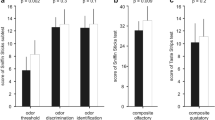Abstract
Essential blepharospasm (EB) is classified as a form of focal dystonia characterized by involuntary spasms of the musculature of the upper face. The basic neurological process causing EB is not known. The purpose of this study was to investigate cerebral glucose metabolism in patients with EB whose symptoms were suppressed by an injection of botulinum-A toxin. Earlier studies were confounded by sensory feedback activities derived from dystonic symptom itself. Cerebral glucose metabolism was examined by positron emission tomography (PET) with 18F-fluorodeoxyglucose (FDG) in 25 patients (8 men and 17 women; age 52.6 ± 10.1 years) with EB. The patients were awake but with the spasms suppressed by an injection of botulinum-A toxin. Thirty-eight normal volunteers (14 men and 24 women; age 58.2 ± 7.3 years) were examined as controls. The difference between the two groups was examined by statistical parametric mapping (SPM99). A significant increase in the glucose metabolism was detected in the thalamus and pons in the EB patients. Hyperactivity in the thalamus may be a key pathophysiological change common to EB and other types of focal dystonia. The activity of the striatum and cerebellum are likely to be sensory dependent.
Similar content being viewed by others
References
Berardelli A, Rothwell JC, Hallett M, Thompson PD, Manfredi M, Marsden CD (1998) The pathophysiology of primary dystonia. Brain 121:1195–1212
Kostic VS, Stojanovic-Svetel M, Kacar A (1996) Symptomatic dystonias associated with structural brain lesions: report of 16 cases. Can J Neurol Sci 23:53–56
Esmaeli GB, Nahmias C, Thompson M, et al. (1999) Positron emission tomography in patients with benign essential blepharospasm. Ophthal Plast and Reconstr Surg 15:23–27
Hutchinson M, Nakamura T, Moeller JR, et al. (2000) The metabolic topography of essential blepharospasm. A focal dystonia with general implications. Neurology 55:673–677
Galardi G, Perani D, Grassi F, et al. (1996) Basal ganglia and thalamo-cortical hypermetabolism in patients with spasmodic torticollis. Acta Neurol Scand 94:172–176
Eidelberg D, Moeller JR, Ishikawa T, et al. (1995) The metabolic topography of idiopathic torsion dystonia. Brain 118:1473–1484
Wakakura M, Tsubouchi T, Inouye J (2004) Etizolam and benzodiazepine induced blepharospasm. J Neurol Neurosurg Psychiatry 75:506–509
Jankovic J, Orman J (1987) Botulinum A toxin for cranial-cervical dystonia: A double-blind, placebo-controlled study. Neurology 37:616–623
Friston KJ, Frith CD, Liddle PF, Frackowiak RS (1991) Comparing functional (PET) images: the assessment of significant change. J Cereb Blood Flow Metab 11:690–699
Friston KJ, Frith CD, Liddle PF, Dolan RJ, Lammertsma AA, Frackowiak RSJ (1990) The relationship between global and local changes in PET scans. J Cereb Blood Flow Metab 10:458–466
Ceballos-Baumann AO, Sheean G, Passingham RE, et al. (1997) Botulinum toxin does not reverse the cortical dysfunction associated with writer’s cramp. A PET study. Brain 120:571–580
Ridding MC, Sheean G, Rothwell JC (1995) Changes in the balance between motor cortical excitation and inhibition in focal, task specific dystonia. J Neurol Neurosurg Psychiatry 59:493–498
Hsiung GY, Das SK, Ranawaya R, Lafontaine AL, Suchowersky O (2002) Long-term efficacy of botulinum toxin A in treatment of various movement disorders over a 10-year period. Mov Disord 17:1288–1293
Tempel LW, Perlmutter JS (1993) Abnormal cortical responses in patients with writer’s cramp. Neurology 43:2252–2257
Garfen CR (1992) The neostriatal mosaic: multiple levels of compartmental organization. Trends Neurosci 15:133–139
Levy LM, Hallett M (2002) Impaired brain GABA in focal dystonia. Ann Neurol 51:93–101
Macia F, Escola L, Guehl D, Michelet T, Bioulac B, Burbaud P (2002) Neuronal activity in the monkey motor thalamus during bicuculline-induced dystonia. Eur J Neurosci 15:1353–1362
Kaji R (2001) Basal ganglia as a sensory gating devise for motor control. J Med Invest 48:142–146
Schmidt KE, Linden DEJ, Goebel R, Zanella FE, Lanfermann H, Zubcov AA (2003) Striatal activation during blepharospasm revealed by fMRI. Neurology 60:1738–1743
Perlmutter JS, Stambuk MK, Markham J, et al. (1997) Decreased [18F] spiperone binding in putamen in idiopathic focal dystonia. J Neurosci 17:843–850
Gao JH, Parson LM, Bower JM, Xiong J, Li J, Fox PT (1996) Cerebellum implicated in sensory acquisition and discrimination rather than motor control. Science 272:545–547
Aramideh M, Ongerboer de Visser BW, Holstege G, Majoie CBLM, Speelman JD (1996) Blepharospasm in association with a lower pontine lesion. Neurology 46:476–478
LeDoux MS, Brady KA (2003) Secondary cervical dystonia associated with structural lesions of the central nervous system. Mov Disord 18:60–69
Author information
Authors and Affiliations
Corresponding author
Additional information
Supported by a generous grant from the Benign Essential Blepharospasm Foundation and Grant-in-Aid for Scientific Research (18991310).
Rights and permissions
About this article
Cite this article
Suzuki, Y., Mizoguchi, S., Kiyosawa, M. et al. Glucose hypermetabolism in the thalamus of patients with essential blepharospasm. J Neurol 254, 890–896 (2007). https://doi.org/10.1007/s00415-006-0468-5
Received:
Revised:
Accepted:
Published:
Issue Date:
DOI: https://doi.org/10.1007/s00415-006-0468-5




